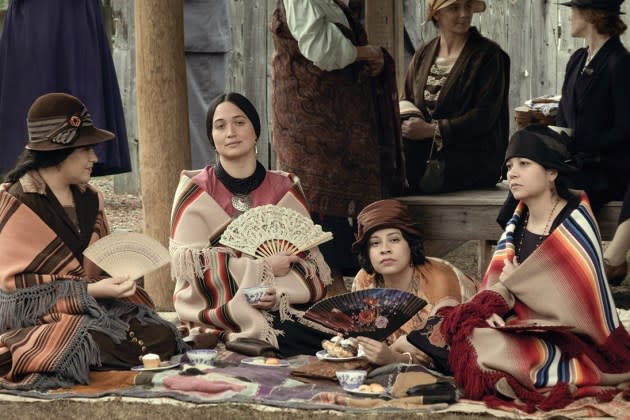How ‘Killers of the Flower Moon’ Casting Directors Assembled the Osage Nation Onscreen
- Oops!Something went wrong.Please try again later.
- Oops!Something went wrong.Please try again later.
- Oops!Something went wrong.Please try again later.
- Oops!Something went wrong.Please try again later.

Casting director Ellen Lewis and head of Indigenous casting Rene Haynes came to Killers of the Flower Moon from very different backgrounds. The former had worked with Martin Scorsese for many years, beginning with Goodfellas. The latter had been at the forefront of casting Indigenous actors in everything from the Twilight series to the HBO film Bury My Heart at Wounded Knee, which earned her an Emmy nom. When Killers came around, says Lewis, “I contacted Rene immediately because I had met her on [the Netflix series] Godless and knew that I was going to want her with me on this journey.”
Haynes was first hired to cast extras for War Party (1988). Production brought her to the Seven Reservations of Montana, where she says she “developed this strong attachment to [the Indigenous] community.” Soon thereafter was Dances With Wolves (1990), which she says “heralded a realization that Native characters should be played by Native actors.” That also boosted the profile of such performers. “My casting colleagues have started to discover those same actors and are not putting them in the niche of Native characters,” adds Haynes.
More from The Hollywood Reporter
The film chronicles the true story of the mass murders of wealthy Osage people in Oklahoma by white settlers wanting to obtain their land rights. When Lewis and Haynes embarked on the project, longtime Scorsese collaborators Robert De Niro and Leonardo DiCaprio had already been cast, as had Jesse Plemons — though the roles of the latter two had not yet been established. “What we didn’t know was: Was Leo going to play [federal investigator] Tom White?” asks Lewis. “Then that flipped — he was going to be Ernest [Burkhart, one of the conspirators in the murder plot], and so we knew that we wanted Jesse for Tom White.”
For the Osage parts, casting necessitated a pre-pandemic open call in Oklahoma. “There are actually 63 Indigenous characters who have named roles in the film, and all but about 14 of them came from that open call,” says Haynes. “We saw 2,500 Indigenous people. I said, ‘Let’s not just make this about casting; let’s make this about building our extras file at the same time.’ Thank goodness we did that because, a few months later, we were into the pandemic and we already had a vast file of people we could draw from.”
One of the most vital roles to cast was Mollie, an Osage woman with an oil fortune who marries DiCaprio’s Ernest. “Early on, Rene brought up Lily [Gladstone], and I had seen her in Kelly Reichardt’s Certain Women. I knew Marty was a fan of Kelly’s,” says Lewis, who adds: “The process of casting is where you open your mind, your imagination. It’s about bringing choices into focus and presenting those choices to a director. People think [we] just think of things off the top of [our] heads. It doesn’t work like that. It’s a very thoughtful process.”
This story first appeared in a December stand-alone issue of The Hollywood Reporter magazine. Click here to subscribe.
Best of The Hollywood Reporter
Eight Actors Who Have Played Willy Wonka in Films and on Broadway
Martin Scorsese’s 10 Best Movies Ranked, Including 'Killers of the Flower Moon'

